
© Takao Komaru. (Click image for larger version)
Ballet v6.0 Festival
Whim W’Him: Monster, Flower Festival, The Sofa
BalletCollective: The Impulse Wants Company, Epistasis
Jessica Lang Dance: A Solo in Nine Parts, I.N.K., Aria, From Foreign Lands and People
New York, Joyce Theater
12, 14 and 16 June, 2013
www.joyce.org
www.whimwhim.org
balletcollective.com
www.jessicalangdance.com
Ballet Camp – A Festival of Young Companies at the Joyce
This summer, the Joyce Theatre has taken advantage of the virtual dead-zone that is mid-August to present a new dance festival, Ballet v6.0, showcasing the work of young choreographers labouring within the vast landscape of contemporary ballet. What distinguishes these new names from choreographers like Christopher Wheeldon or Benjamin Millepied is not only their age and experience but also the fact that, either by choice or by necessity, they’re working outside the realm of the major ballet houses. They’ve struck out on their own. Some of these budding impresarios, like Charles Anderson, of Company C – which performed last week – have set out to create small repertory companies, commissioning works. Others, like Troy Schumacher, whose BalletCollective performed on August 14-15, are attempting to forge new models for making dances. Still others, like Jessica Lang (August 16-17), are essentially free-lancers – and successful ones – who feel the need to consolidate their presence with an ensemble of their own. Each participant is unique in his or her approach and ultimate goal.
In his early days as a moody experimentalist, Balanchine, too, formed an ensemble, the Young Ballet, beyond the reaches of the Mariinsky Theatre where he had received his training. It was the early twenties, a heady time for dance, post-Revolution. All sorts of new and exciting things seemed possible, new ideas about movement and about content. (The critic and scholar Elizabeth Kendall captures this creative avalanche with great vividness in her new book, Balanchine and the Lost Muse.) We are not living in such an age today, alas, though ballet has received a jolt of energy from the inventiveness and sheer fluidity of choreographers like Alexei Ratmansky and Christopher Wheeldon. And now, it seems, there is a new generation, led by Justin Peck, no older than many of the choreographers in this showcase. But there are lingering questions in people’s minds about ballet’s validity. Mainly, these tend to focus on the academicism of its forms, on the question of what is suitable content for dance, and, inevitably, on the stark gender division implied by the pointe shoe. What are the ethics and esthetics of dancing on pointe in 2013?
Jessica Lang Dance from Show Love on Vimeo.
The six groups in the festival took different approaches to these and other issues. I caught the final three: Whim W’him (Aug. 12), BalletCollective (Aug. 14), and Jessica Lang Dance (Aug. 16). In a way it is disheartening to see that so many younger choreographers, encouraged by the output of European figures like Jiri Kylian and Antonin Preljocaj, seem to be simply turning their back on the pointe shoe, as if it were an outdated, useless garment, something akin to the corset. (Interestingly enough, many of these same choreographers favor the corset, or an updated, stretchy simulacrum of it, usually paired with briefs, for both men and women. Audiences have seen this combination so often that it barely registers anymore. Is it meant to erase gender? Similarly, we hardly notice the giant splits that dominate a large swathe of contemporary choreography. Have we replaced the fetishism of the foot with the fetishism of the groin?)
Once the pointe shoe has been eliminated, what qualities differentiate contemporary ballet from its nearest cousin, modern dance? The technique, for one – the emphasis on “pulled-up” muscles, held-in stomachs, artificially placed legs. And as a corollary, a lack of weightedness in the movement. When Paul Taylor dancers land from a jump, you hear them hit the ground, and you feel the weight of their bodies. When they launch themselves into the air, the whole body takes part in the effort. When ballet dancers do these things, the effort is isolated in certain parts of the body, effectively concealed. Even as ballet dancers add fluidity and breadth to their torsos and arms, they retain a certain look of composure and stretch. It’s most noticeable when they run – they don’t run like normal people, but like nymphs, with their shoulders back, arms slightly stiff, torsos straight. Like the velcro corsets, the ballet run is a simulacrum.
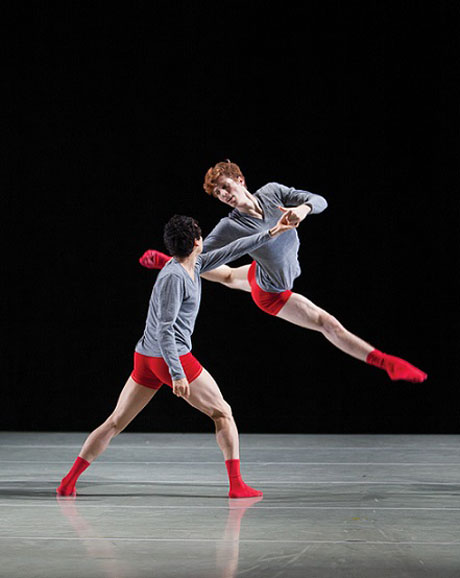
© Bamberg Fine Art.
A lot of contemporary ballet choreographers are interested in fighting this effect and creating a more weighted feel. It appears that this group includes Olivier Wevers, whose group Whim W’Him performed at the festival on August 12-13. (Wevers is a former member of Pacific Northwest Ballet.) With only one exception, the women were off-pointe; most of the time: the dancers wore socks, the better to slide around in and feel the floor beneath their feet. Legs were bent, turned in. Torsos buckled, heads were often tilted downward (the classical ballet dancer traditionally looks up and out, toward the horizon). Wevers’ subject matter is also intentionally weighty. The first dance, Monster, deals with addiction, the struggles of same-sex lovers in society and the torments of love in general. The music is a mashup of mood-setting electronic pieces by Max Richter, Alva Noto, and Ludovico Einaudi (all recorded, like most of the music in the festival). In the pauses between pieces, a man’s voice (also recorded) intones an all-too solemn poem, by RA Scion, about the monsters hidden inside us. The lighting installation (uncredited), which gleams from two rows of vertical fluorescent bulbs, is chic. But for all its seriousness, the dance feels flimsy and predictable, too reliant on effects like a hand covering a face, an outstretched arm, tormented twitching. The gestures are histrionic but empty.
As I watched the final section of Monster, an anguished pas de deux, I began to wonder why so many contemporary male-female duets in ballet devolve into this kind of appalling near-abuse. The woman (Melody Mennite, of Houston Ballet) clings to her lover, jumping onto his back, swinging from his shoulders; the man (Lucien Postlewaite, of Pacific Northwest Ballet) kisses her, but also grabs her neck, drags her across the stage by her arm, pulls her forcefully onto pointe, emits a silent scream. These signs of distress alternate, incomprehensibly, with acts of tenderness, cradling, caresses. The dance is like an extended series of emotional non-sequiturs. If we knew people who behaved this way, wouldn’t we be horrified? Why, then, has this sort of histrionic interaction become a commonplace in ballet? And why does Wevers decide to put the woman on pointe at precisely this moment? Does he see the toe shoe as synonymous with the abuse of women?
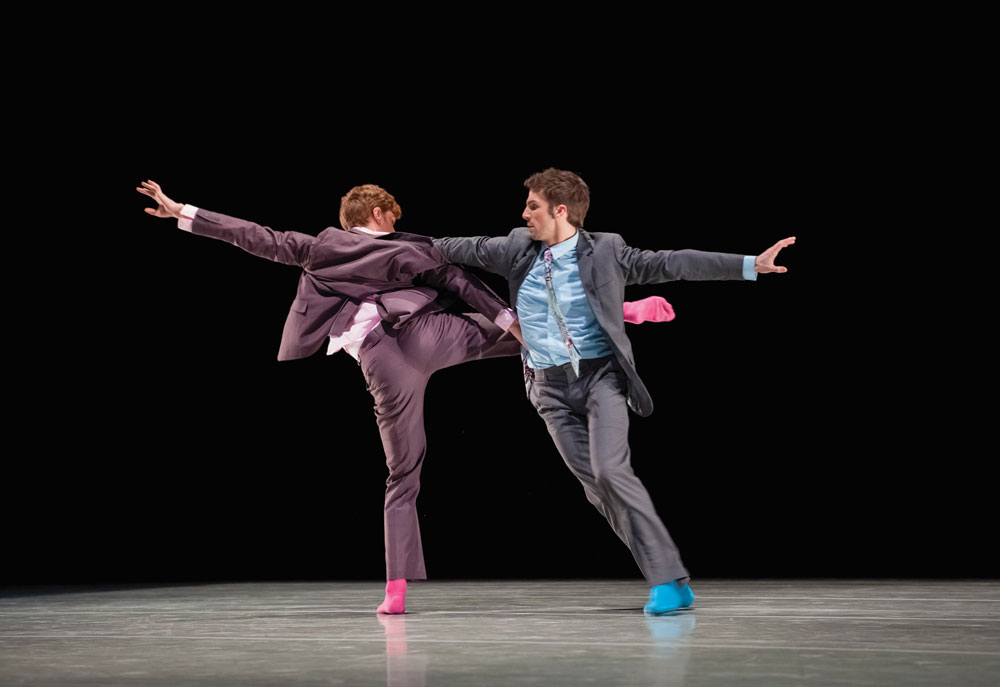
© Bamberg Fine Art. (Click image for larger version)
This question was not answered over the course of the evening. Luckily, the remaining works on the program were less aggressive. Flower Festival, a duet for two men, is set to a suite of sunny dance numbers by Edvard Helsted, music written to accompany the nineteenth-century Danish classic Flower Festival in Genzano. Here, Wevers riffs on what was originally a cheerful peasant pas de deux, with its various solos and tender partnering sequences. By casting it for two men, he creates a curious and sometimes witty dialogue with the nineteenth-century tradition. His Flower Festival benefits from the music’s highly structured form and changes of mood, allowing for a series of variations for each of the men, as well as passages of clever partnering. Some of the manipulations are accomplished with the assistance of various articles of clothing: a rolled up jacket wrapped around the arms, a pair of trousers used as a kind of tether. The final piece, The Sofa, is also semi-comic. Wevers responds to the jaunty classicism of an early Mozart piano concerto with finicky, pseudo-Baroque hand gestures; the centerpiece of the dance is a sofa; the dancers sit on it, turn it on its side, jump over it, slide against it, hide under it. The busy activity leads into another, somewhat less torturous, pas de deux, in which a man (Nicholas Schultz, of Grand Rapids Ballet) clad in a purple corset and briefs alternately lowers a similarly-dressed woman (Yuka Oba, also of Grand Rapids) to the floor, holds her limp body in his arms, slides her across the stage, or lifts her into the air, legs splayed. Perhaps because it is off-pointe, its feel is more subdued, less hostile.
The next ensemble to perform was Troy Schumacher’s BalletCollective. The two works on this program were collaborative efforts in every sense, with Schumacher – a member of the corps of New York City Ballet – as the central link in a chain of artistic partners. Here, all the women were on pointe; in this sense, Schumacher is content simply to allow the dancers to do what they do best. (And it must be said his dancers, all of whom are current or former City Ballet dancers, look marvelously at home in his vocabulary of movement.) For his newest work, The Impulse Wants Company, he has called upon the creative input of the poet Cynthia Zarin, the young composer Ellis Ludwig-Leone, and the lighting designer Brandon Sterling Baker. The compositional method is unique enough to deserve mention. First, the collaborators sat down to discuss their ideas. Then Zarin went off and wrote a poem. Based on motifs and images from the poem, a score was composed by Ludwig-Leone. Both the music and the poem formed the basis for Schumacher’s choreography, made in collaboration with the dancers. In this way Zarin’s words became a kind of subliminal through-line for the dance, which, as Schumacher points out in a program note, will continue to evolve over time.
I’ll admit that I found little connection between the choreography and Zarin’s words, which were distributed before the show. (The rather lovely poem makes reference to a series of seaside memories.) In fact, my greatest criticism of The Impulse Wants Company was that, for all its conceptual unity of vision, it lacked coherence. It felt like a series of images or interactions, connected by jagged transitions. The ending came as a complete surprise, both musically (harmonically) and in terms of what was going on onstage. But despite the choppiness, the dancing, moment-by-moment, held one’s attention. It felt fresh, intriguing and strange, in a good way; Schumacher seemed to be reaching for images and storylines beyond the usual narratives of tormented relationships. The dancers shone through the choreography with great power; I can remember each of them quite distinctly. Harrison Coll’s plangent, dissatisfied air and Kaitlyn Gilliland’s dreamy introspection left their mark on the movement. For Lauren King, a self-effacingly sweet dancer, Schumacher created a solo of great poetry, with meditative little foot-drags and spins on bent legs. Taylor Stanley bounded across the stage with electric jumps, as if trying to avoid singeing his feet on hot coals. The interaction of the live musicians and dancers felt real and alive.
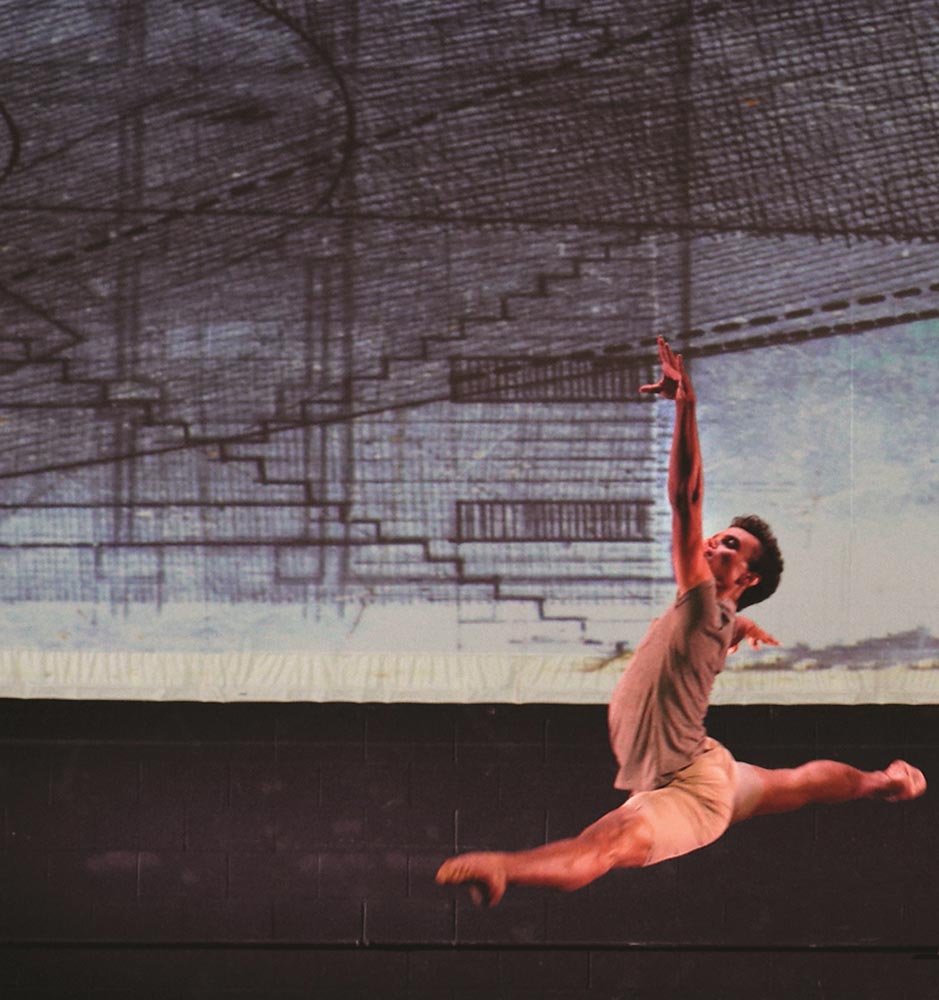
© Lora Robertson. (Click image for larger version)
Schumacher’s ballet was very much a dance about the dancers, their identities, their moods, their sense of community. A pitfall of this approach is that it creates a kind of adolescent ambiance of self-discovery. (This “we’re just kids” feeling is reminiscent of Jerome Robbins, a clear influence.) But Schumacher is also interested in tweaking certain conventions of classical dance, with turned-in knees and a smattering of casual, everyday gestures. Often, he has women partnering men, which almost always looks unconvincing. One can’t feel the women’s arms really supporting the men’s weight; it feels fake. The second piece, Epistasis, from last year, is in many ways more successful, in part because the music is more dynamic and has a clearer rhythmic pulse. (Choosing the right music is half the battle.) The score for Epistasis was composed by a group of folk-classical musicians – Nick Jaina, Nathan Langston, Amanda Lawrence and David Moss – and it sounds even better now that it has been arranged by Ludwig-Leone. One hears echoes of tango, Eastern European folk music, even a tarantella. In response, Schumacher has created what is probably his most vivid pas de deux, a sensual ballad for Ashley Laracey (a luminous dancer) and Taylor Stanley, in which the two circle each other like Adam and Eve in the Garden of Eden, picking flowers out of the air with their fingers. What it’s all about one never really knows, but the enigmatic mood lingers. So, even if the dances on the program don’t quite add up, there’s still much to admire.
From the first moment that Jessica Lang’s troupe took the stage on August 16, it was clear that Lang was the most polished and accomplished choreographer of the festival. The four works on the program were tight, handsome, stylish. Any decent ballet troupe would be lucky to have one in its repertory. (Two of them were outside commissions.) Each was created using a different mold: A Solo in Nine Parts was pure Paul Taylor-esque joy and energy, down to the simplified outstretched arms, Vivaldi accompaniment and giddy final solo. I.N.K. was a hyper-stylized (one might say gimmicky) number in which the dancers morphed into calligraphic shapes and interacted with video projections of slow-motion water drops. (This piece would not have been out of place at a MOMIX show.) Aria – the only piece to include pointe work – was a giddy duet set to a recording of a manic Handel aria (“Son contenta di morire,” from Radamisto), breathily sung by a mezzo with questionable Italian diction.

© Takao Komaru. (Click image for larger version)
From Foreign Lands and People, the most imaginative and sincere work of the evening, was a kind of Dances at a Gathering in which eight dancers gracefully interacted, coupled, daydreamed, and frolicked to piano works by Schumann (played with beautiful simplicity by Taka Kigawa, live). Lang added a pictorial element as well, a cluster of black rectangular set pieces that were moved around the stage to create passageways, bridges, platforms. At times the manipulations became a distraction, but the blocks did create a kind of shifting landscape in which the characters acted out their private dramas, as when one of the women appeared to drown near a bridge, and a man threw himself after her in despair. The evening was satisfying in many respects, including musical, but, look as one might, it was impossible to decipher a clear identity beyond the compositional mastery. Lang is a highly competent dancemaker, and a chameleon. Her dances may not represent the future of ballet, but they are a satisfying extension of its present and its past.













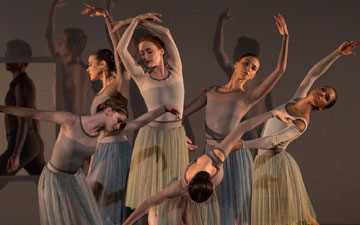
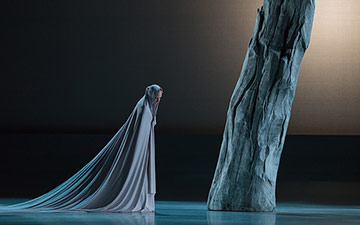

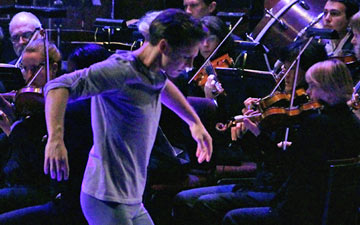
[…] a little hiatus, here’s my first review of the pre-season, for DanceTabs. It’s a roundup of the second half of the so-called “Ballet v6.0 Festival,” a […]
It’s such a pleasure to read Marina Harss, and I look forward to her entries.
In this latest essay, I was happy to read her comments about fetishes — the
frontal grand jete is perhaps the most innocuous display of the groin, particularly female. Thank you for saying it.
Fine thoughtful thought-provoking review. Maybe the paucity of pointework is due to the shortage of polished professional dancers outside the main companies (here in London, it seems). It’s so difficult for ballet-based choreographers to get access to dancers, rehearsal space and a showcase if they’re not in a company.
Agree with your beef about same-old unisex garments, including the vest/camisole top and briefs, bare legs and socks. Inexpensive, of course, but designers could try harder.
Dear Jann and Renee, thanks for your comments. You know, Jann, I doubt that what you mention is the problem, at least here in the US. Strong dancers are not in short supply, in fact I often thing that there is such a surfeit of training here, it far outstrips the number of opportunities. all of these choreographers are working with highly-skilled professionals. It’s the interest that’s lacking, for the most part. Which is why Schumacher’s choreography, for all its structural shortcomings, feels so refreshing. His dancers look glorious on pointe, and he uses their skills without falling into the clichés of prettiness. Cheers to both!
nota bene: it’s Angelin Preljocaj, not Antonin.